A new movement has taken off in personal growth: neurohacking. It’s all about making your brain work better on your own. This DIY brain boost started in late 20111. People began making their own devices to send tiny electric signals to their brains.
Neurohacking includes many ways to make your brain better, like using special supplements and trying out biohacking. It’s part of the “life hacking” trend, where people track their lives to get better at things. The nootropics forum on Reddit has 80,000 followers1, showing how popular it is.
Now, thousands of brain devices are being sold every year1. There’s no official market size, but the potential for growth is huge. People are trying out things like brain stimulation and guided meditation2 to get better at what they do.
Key Takeaways
- Neurohacking is a DIY way to make your brain work better.
- It started in late 2011 with people making their own brain devices.
- It includes things like making your own brain boosters, using special supplements, and biohacking.
- More people are getting into it, shown by online forums and device sales.
- They’re trying different methods, like brain stimulation and meditation, to improve their brains.
Introduction to Neurohacking
Welcome to the exciting world of neurohacking. Here, we use advanced techniques and tools to make our brains work better and think sharper. I’m thrilled to share the basics of neurohacking and how it can change our mental health and brain power.
Neurohacking is all about improving our brain skills using different methods. These methods include using nootropics, brain devices, meditation, and brain exercises3. We use these tools to boost our focus, creativity, memory, and overall brain function.
Recently, neurohacking has become more popular. Many people want to improve their mental skills. Courses like “Introduction to Neurohacking In R” at Johns Hopkins University teach us about brain imaging and how to work with brain data4. With 23,590 learners and a 4.6 rating from 299 reviews, it shows people are really interested in this field5.
Starting our neurohacking journey means understanding that most mental health comes from basic habits. These include getting enough sleep, eating well, and moving around. Being with positive people also helps a lot, as we tend to be like those we spend time with3.
The mind is not a vessel to be filled, but a fire to be kindled. – Plutarch
In this article, we’ll look at different parts of neurohacking. We’ll talk about DIY brain techniques, nootropics, brain training, and meditation. We’ll also check out the newest tools and devices for the brain.
As we learn more about neurohacking, it’s important to see both the good and the bad sides. Let’s dive into this exciting journey together. We’ll discover how to make our brains work better and unlock our hidden potential.
The Rise of DIY Brain Stimulation
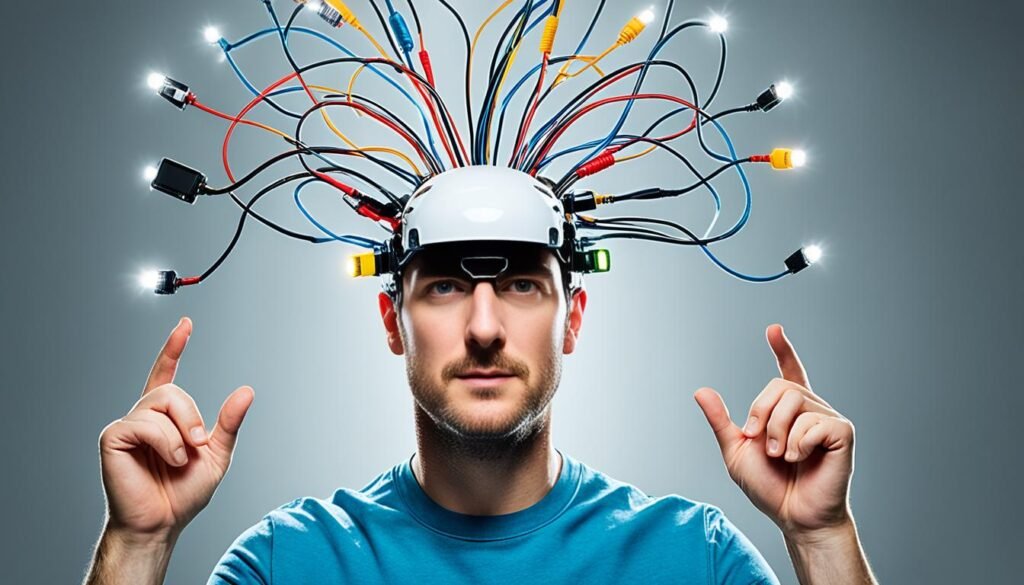
In recent years, people have started to explore ways to make their brains work better. They’ve looked into DIY brain stimulation methods like tDCS, tACS, and tRNS. This movement began in late 2011 when people started making their own devices to improve their minds67.
Even though more people are interested in DIY brain stimulation, it’s still a niche. Media like Radiolab, Wired, and the New Yorker have covered it6. But, many who started using it have stopped. Forums like Reddit show that many people who were once into it are no longer active67.
Transcranial Direct Current Stimulation (tDCS)
tDCS uses a weak constant current on the brain through scalp electrodes. It’s popular for its ease and possible benefits like better focus and memory6.
Transcranial Alternating Current Stimulation (tACS)
tACS uses currents that change to match brain waves. It tries to improve focus and memory by changing brain activity6.
Transcranial Random Noise Stimulation (tRNS)
tRNS applies random electrical noise to the brain. It’s new and aims to make the brain more adaptable and improve thinking by changing neural patterns6.
DIY brain stimulation sounds appealing but needs caution. Users may feel tingling, headaches, or skin issues. The long-term effects are still unknown, and more research is needed67.
As neurohacking grows, we must weigh its benefits and risks. Encouraging responsible use and supporting research can help. This way, we can safely explore these techniques and improve our minds.
Nootropics and Smart Drugs
People are now looking into nootropics and smart drugs to boost their brain power. The market for brain supplements is expected to hit $11.6 billion by 2024. This growth is thanks to more people wanting to improve their mental abilities8. Nootropics, or brain supplements, help with things like memory, creativity, and motivation.
The interest in nootropics surged in 2015, thanks to Silicon Valley’s investment8. People, known as neurohackers, use these substances to get better at analyzing things, perform better at work or school, and be more creative9. They aim to make their brains work faster, remember things better, and think more clearly.
Synthetic Nootropics
Synthetic nootropics are made in labs to improve specific brain functions. Some popular ones are:
- Piracetam: It might help with memory and learning.
- Noopept: This nootropic could boost memory, focus, and brain function.
- Modafinil: It’s used to stay awake, alert, and productive.
But, it’s important to know that supplements don’t get checked by the FDA. This means they can vary a lot in what they actually contain8. Research says no single supplement is proven to work well, except for B vitamins for some people8.
Natural Nootropics
Natural nootropics come from plants and herbs. Some examples are:
- Ginkgo biloba: It might help with memory and thinking skills.
- Bacopa monnieri: This plant could improve memory, mood, and thinking in healthy people9.
- Lion’s Mane mushroom: It might support brain health and help grow new brain cells.
Studies show that Bacopa monnieri can help right away and lower stress hormones9. Supplements like acetyl-L-carnitine can also make thinking and feeling tired better9.
Natural nootropics are seen as safer than synthetic ones, but be careful. Experts say to get brain-boosting nutrients from foods like leafy greens and nuts8. Omega-3s and vitamin E can also help brain health8.
Caffeine is one proven nootropic, but don’t have more than 400 milligrams a day8. Your lifestyle affects your brain too. Not sleeping well can hurt your thinking and memory8. Exercise like running can make your brain healthier by increasing blood flow8.
As more people look into smart drugs, it’s key to use a full approach. This includes diet, exercise, brain games, and the right supplements and nootropics9.
Brain Training and Cognitive Exercises
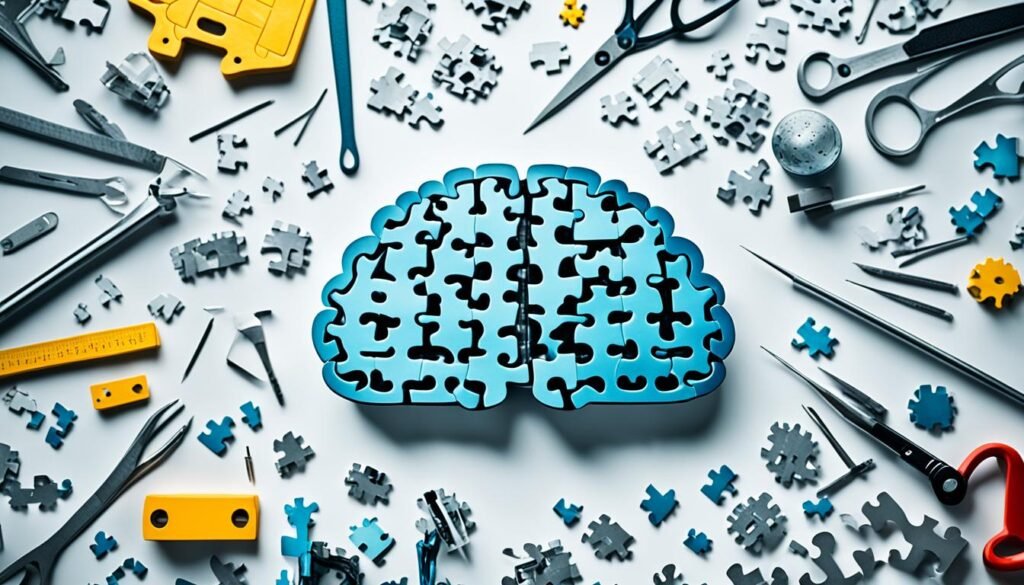
I’ve been looking into brain training and cognitive exercises to boost my brain power. These activities aim to make our brains work better. They include games and puzzles that keep our minds sharp as we get older10.
Take Roger Craig, who won a lot of money on Jeopardy! in 2010. He used special learning methods to remember lots of information11. This shows how brain training can really help us learn and remember better11.
Learning new skills or doing hard puzzles can change our brains for the better10. Musicians have bigger brain areas for music than people who don’t play music10. Even a little bit of music training can make our brains work better, especially for older people10.
Playing video games can also make our brains stronger in areas like memory and problem-solving10. Learning a new language can make our brains better at understanding language and keeping our brains healthy10.
Using a special memory method can make our brains thicker in areas that help with memory10. Doing brain exercises can change our brains in good ways, making our memory better10.
Smartphones and apps make it easy to track our brain health and try out new training methods11. Groups like Quantified Self and NeuroTechX share tips and stories on how to improve our brains11.
Exploring new places can make our brains work better and help us learn10. Sleep is also key for learning and remembering things, with the best sleep coming right after we learn something new10.
| Brain Training Activity | Cognitive Benefits |
|---|---|
| Memory Games | Improves memory retention and recall |
| Problem-Solving Puzzles | Enhances critical thinking and reasoning skills |
| Musical Training | Increases gray matter volume and neural efficiency |
| Video Games | Boosts spatial navigation, working memory, and executive control |
| Language Learning | Supports language processing and white matter integrity |
I’m excited to keep learning about brain training and cognitive exercises. I believe they can really help me improve my thinking skills. By using these methods every day, I hope to make my brain work its best.
Meditation and Mindfulness Techniques
As a neurohacker, I’ve seen big improvements in my brain health by adding meditation and mindfulness to my daily life. Meditation boosts focus and memory, making it as effective as a 16 percentile point increase in GRE scores after just a few weeks12. Long-term meditators also keep their brains healthier, with more grey matter than those who don’t meditate12.
I practice two main types of meditation: focused attention and open monitoring. Focused attention means keeping your mind on one thing, like your breath. Open monitoring is about watching your thoughts and surroundings without judgment. Both improve brain areas for memory, learning, attention, and handling emotions13.
Focused Attention Meditation
For focused attention meditation, I set aside time each day to sit quietly and focus on my breath. This practice protects memory and increases brain volume, possibly because it reduces stress13. Even a short meditation before studying can boost exam scores, showing how it helps with memory13.
Open Monitoring Meditation
Open monitoring meditation lets you watch your thoughts and feelings without getting caught up in them. It changes how different brain areas connect, making the “fight or flight” center weaker and attention stronger13. After eight weeks, the amygdala gets smaller, and the prefrontal cortex, which handles complex brain tasks, gets thicker13.
I value meditation for its short-term and long-term brain health benefits. Long-term meditators have brains that seem 7.5 years younger than non-meditators, suggesting it may slow down brain aging13. With 20 years of meditation, the prefrontal cortex stays thick even with age13.
Meditation also lowers stress over three months and can ease mental and physical pain better than morphine12. It boosts creativity and problem-solving skills too12.
To help me meditate regularly, I use tools like the Muse headband. It gives me real-time feedback on my brain activity. Adding these techniques to my neurohacking tools helps me stay focused, creative, and keep my brain healthy13.
Neurohacking Tools and Devices
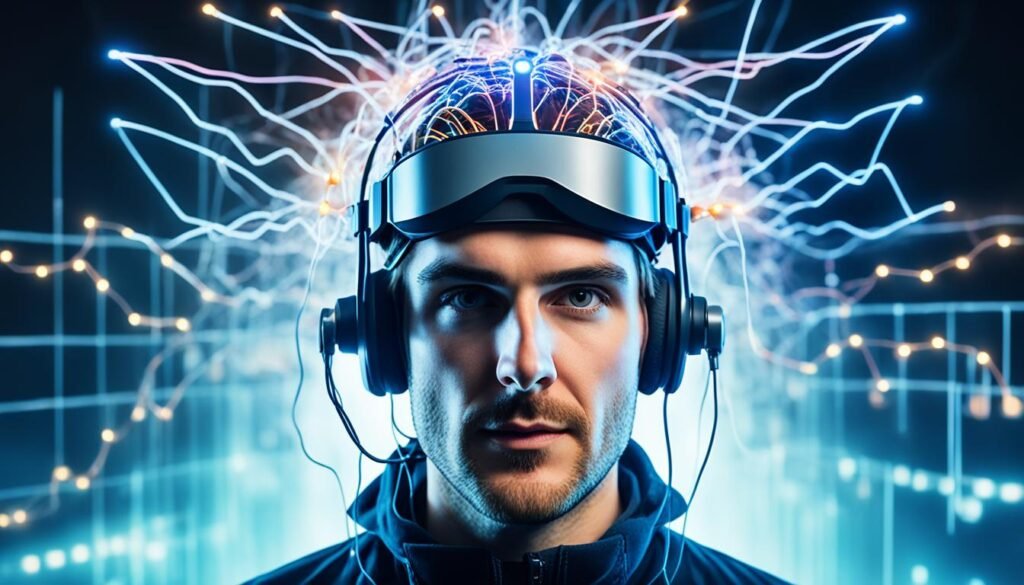
The world of neurohacking is growing fast, bringing new tools and devices to help people improve their brain function and thinking skills. These tools come from the latest in neuroscience research, making advanced tech easy for everyone to use14.
EEG Headsets
EEG headsets are a top choice for neurohackers. They use Electroencephalography (EEG) to record brain signals from the scalp14. With these headsets, people can see their brain waves live and even control devices with their thoughts.
The Zeo Sleep Manager Pro is a special EEG device for tracking sleep15. It helps users understand their sleep patterns better, leading to better sleep and sharper thinking.
Neurofeedback Devices
Neurofeedback tools are key for neurohackers too. They show users how their brains work in real-time, helping them change their brain activity. This can improve thinking and feelings by changing the brain’s pathways14.
Neurofeedback is also helping with issues like addiction and controlling impulses16. It’s a new way to fight cravings by changing brain signals, leading to healthier habits14.
| Device | Features |
|---|---|
| ActiGraph GT9X Link | Heart rate monitoring, activity tracking, sleep monitoring15 |
| Fitbit Alta | Heart rate tracking, activity monitoring, sleep stage analysis, phone integration15 |
| BEDDIT 3 Sleep Monitor | Placed under sheets to monitor sleep patterns15 |
Even though we’re still studying how well these devices work, they mark a new chapter in neurotech. As we learn more about the brain, EEG headsets, neurofeedback tools, and brain-computer interfaces will likely help people more and more. They’re giving people the power to improve their brain health and performance in big ways.
Biohacking and Quantified Self Movement
Biohacking and the quantified self movement are linked with neurohacking. Biohackers work on making their bodies better by changing what they eat, how they exercise, sleep, move, and think. This helps them feel better overall17. The biohacking movement uses medical, nutritional, and electronic ways to manage our biology. It includes using things like nootropics and devices to track our health18.
The quantified self movement is about tracking different parts of our lives, like our diet, workouts, sleep, and feelings. Studies show that focusing on diet, sleep, exercise, and other natural ways is becoming popular for improving brain function19. Neurohackers also track and test themselves to make their brains work better. They aim for things like being more productive, creative, sleeping well, feeling less anxious, being more empathetic, and feeling better overall17.
Grinders, a group of body hackers, connect with the biopunk movement, open-source transhumanism, and techno-progressivism. Biopunk stands for making genetic info open and supporting democratic tech growth. It encourages biohackers to do things themselves18.
More people are using nootropics, substances that make our brains work better. This includes things like natural supplements and prescription drugs19. Biohackers and those into the quantified self movement try out different ways to improve themselves. They pick what works best for their genes and how they react to things19.
Some big names in biohacking and the quantified self movement are:
- Kevin Warwick
- Steve Mann
- Amal Graafstra
- Lepht Anonym
- Winslow Strong
- Tim Cannon18
These people are famous for their work and new ideas. They’ve tried LED implants, night vision boosts, and using biometric data from the body18. Groups like Grindhouse Wetware, KSEC Solutions, and BioViva work on biotech and gene therapy. They’re pushing the limits of biohacking18.
The biohacking and quantified self movement is growing. We need to think about how to regulate it, make it safe, make it accessible, and think about ethics19. By using science and technology wisely, we can improve our lives and open up new ways to enhance ourselves17.
Risks and Ethical Considerations
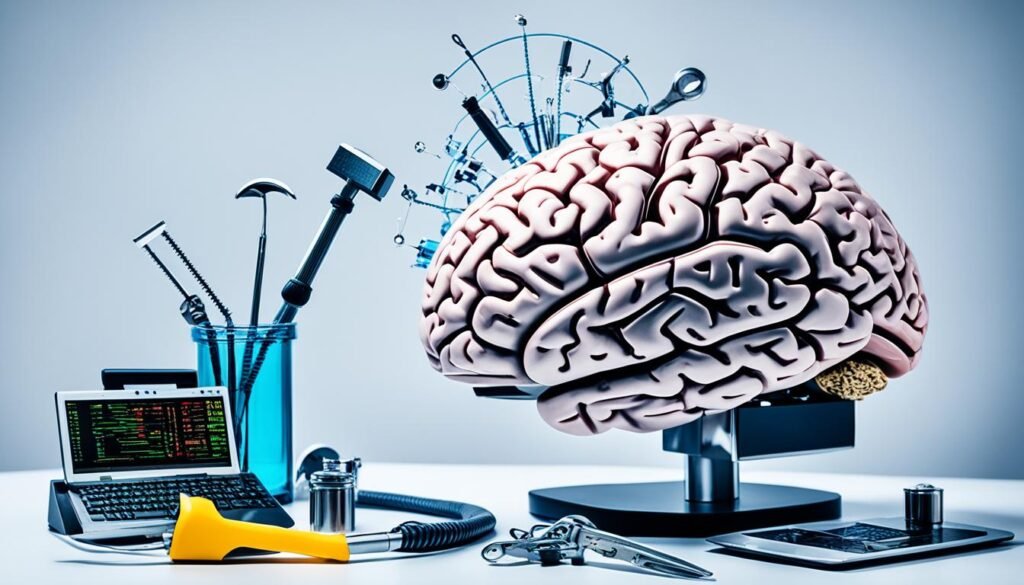
Neurohacking is growing fast, but we must think about the risks and ethics. The idea of making our brains work better is tempting. Yet, we need to look at the safety, long-term effects, and the need for rules in this area.
Now, brain-computer interfaces (BCIs) are getting a lot of attention. Companies like Neuralink and Facebook are investing in them20. But, a special kind of BCI that affects emotions hasn’t been checked closely enough20. Researchers are working on these to help people with ALS and others, and they could change how we talk and have fun online20.
Safety Concerns
Using DIY brain tricks can be risky. Without a doctor’s help, people might get hurt or have their brains change in bad ways. There’s no one to check if these gadgets are safe or work right, making things worse.
Long-term Effects
We don’t know what using neurohacking can do to our brains over time. Some say it helps, but we need more studies. We don’t know the full effects yet.
Regulation and Oversight
Neurohacking is getting more popular, and we need rules. Right now, there aren’t many rules for these products, so users are at risk. We need clear rules to keep people safe and stop false claims.
A study in 2020 talked to neurohackers about their views on these technologies21. They looked at many kinds of gadgets, like brain chips and special implants21. The interviews were long and covered many topics21.
| Neurohacking Technology | Potential Benefits | Potential Risks |
|---|---|---|
| Nootropics | Improved cognitive function, enhanced memory and focus | Unknown long-term effects, interactions with other medications |
| Transcranial Direct Current Stimulation (tDCS) | Improved learning and attention, treatment of depression and anxiety | Skin irritation, headaches, unintended changes in brain function |
| Brain-Computer Interfaces (BCIs) | Restored communication and control for individuals with paralysis or neurological conditions | Invasive procedures, risk of infection, privacy concerns |
We need to be careful with neurohacking. We should think about the good and the bad sides. Talking openly and making safe rules can help us use these new things right.
Scientific Research on Neurohacking
Neurohacking has seen a big increase in interest since the early 2000s. This is after a period where research was limited22. Now, scientists are studying how cognitive enhancement and brain optimization work. A scoping review shows us the different meanings and ethical thoughts on neurohacking.
Studies have looked into how nootropics affect the brain, starting in 197222. These include synthetic and natural compounds that might help with memory, focus, and thinking. Researchers have tested these to see if they can improve cognitive skills.
Techniques like transcranial direct current stimulation (tDCS) are now being studied a lot in neurohacking. Scientists have mapped different parts of the brain to find the best way to use tDCS23. They found that tDCS can boost learning for three hours after just 30 minutes, helping with new skills faster23. Other methods like deep brain stimulation (DBS) and transcranial magnetic stimulation (TMS) are also being looked into for their effects on the brain22.
“The use of tDCS can lead to three hours of enhanced learning after only 30 minutes of application, potentially accelerating the acquisition of physical skills.”23
Now, there are thousands of articles on neurohacking, showing how much it has grown23. But, many studies have small samples and mixed results. This means we need more research to know if these methods are safe and work well long-term. It’s important to think about ethics and regulation to avoid misuse24.
Even with caution, neurohacking research could be very beneficial. It could help treat conditions like Parkinson’s disease and improve focus and productivity23. As we learn more, it’s key to balance our understanding of the brain with the safety of those trying neurohacking.
Neurohacking Communities and Resources
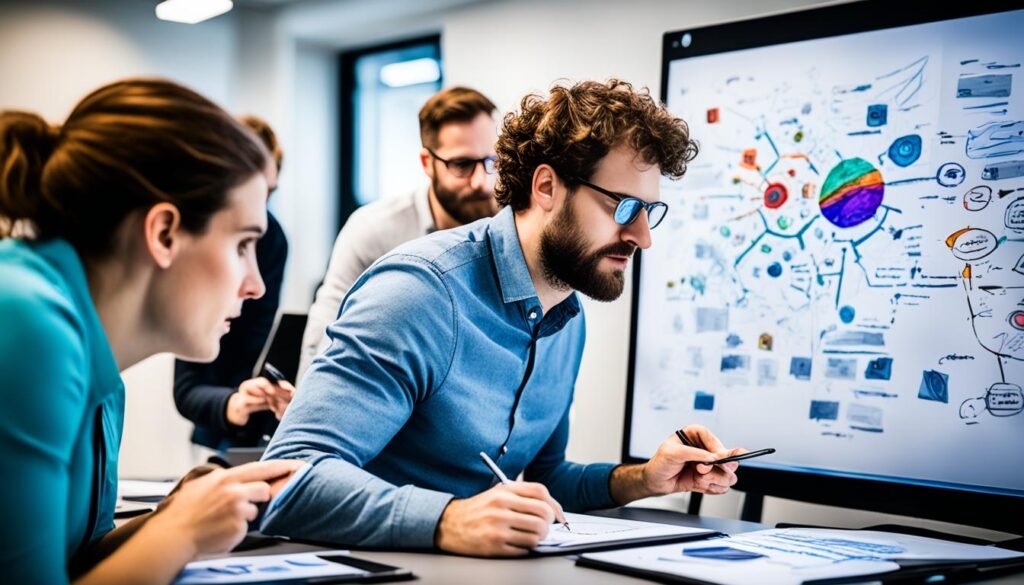
The neurohacking community has grown a lot in recent years. People are looking to improve their brain power and overall health with new techniques and tools. These DIY scientists aim to free us from old ways of thinking and make our minds and bodies more valuable25. They meet online and in person, sharing their knowledge and working together.
Reddit is a big place for neurohackers to talk and share ideas. Subreddits like r/nootropics and r/tDCS have thousands of followers. These forums are full of the latest research, personal stories, and advice on how to improve your brain.
At conferences and biohacking events, neurohackers come together to learn and share. Events like the Biohacking Congress and NeuroFutures bring experts and enthusiasts together. They talk about new discoveries in neurohacking and how to use them.
Online Forums and Discussion Groups
Online forums are key for the neurohacking community. They let people connect, share what they know, and learn from each other. Some top places to check out include:
- r/nootropics: This subreddit has over 180,000 followers. It’s a spot for talking about brain boosters, mixing different supplements, and how to use them safely.
- r/tDCS: With over 14,000 followers, this forum is all about transcranial direct current stimulation (tDCS). People talk about making devices, trying out different settings, and staying safe.
- Longecity: This forum has been around for a while, focusing on living longer and thinking better. It has sections on brain boosters, hacking your body, and the latest in brain science.
- Biohack.me: This site is all about biohacking, including improving your brain, tracking yourself, and doing your own biology experiments.
Conferences and Events
Events and conferences are great for neurohackers to meet experts, network, and keep up with new discoveries. Some big ones to look out for are:
| Event | Location | Frequency | Focus |
|---|---|---|---|
| Biohacking Congress | Miami, USA | Annual | New research and ideas in biohacking and living longer |
| NeuroFutures | Various locations | Annual | Looking into the future of brain tech and its uses |
| AxonLabs Neurostimulation Conference | Online | Annual | Workshops and talks on brain stimulation like tDCS and tACS |
| Quantified Self Conference | Various locations | Annual | Exploring how to track yourself and use tech to improve health and work |
Getting involved with the neurohacking community online, in groups, and at events helps people learn and grow. These resources are key to the future of improving our brains and changing society.
Future of Neurohacking
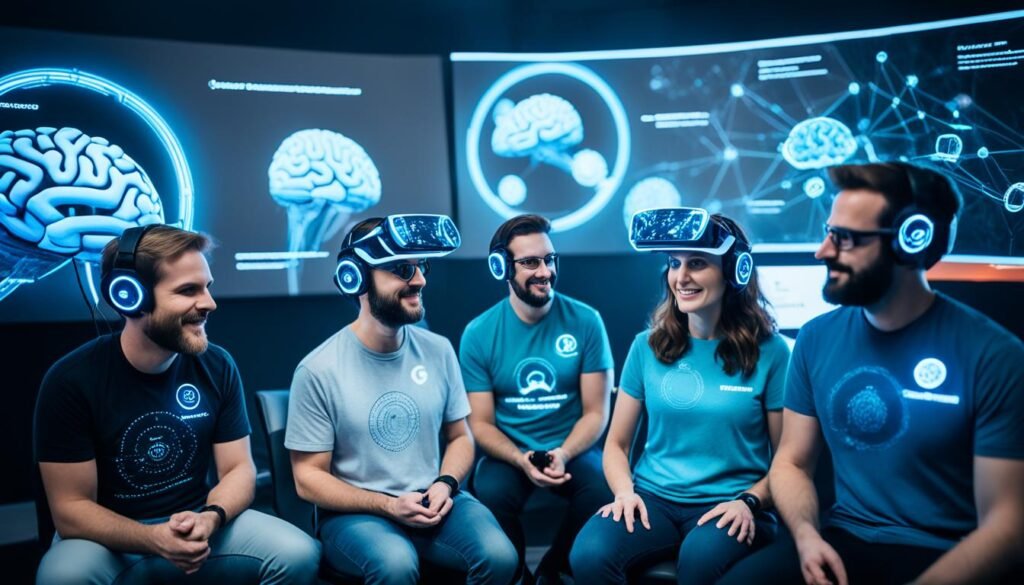
Looking into the future of neurohacking, we see big changes coming. These changes will change how we see the human brain and what it can do. The biohacking industry is growing fast, now worth about $14 billion (€12.9 billion)26. Neurohacking is a key part of this growth26.
New tech like non-intrusive brain-computer interfaces (BCIs) is exciting. For example, Neurable headphones are easy to use and could change how we think about cognitive enhancement26. They’re set to be in a big headphone brand later this year, showing they’re becoming more popular26.
But, we must think about the risks and ethics of these new techs. The Internet of Things makes us more vulnerable to cyber threats, from robots to medical devices27. Also, the idea of being blackmailed by threats to erase memories is scary27.
“The future of neurohacking is both exhilarating and daunting. As we unlock the secrets of the brain, we must navigate the ethical and regulatory landscape to ensure responsible innovation.”
Despite the risks, neurohacking’s future looks bright. It could help us think better and treat brain disorders. Companies are working on drugs like NSI189 to help with stress and nerve damage28. Exercise, especially weight lifting and high-intensity workouts, can also boost brain health28.
As neurohacking grows, we need rules to keep us safe and ethical. Finding the right balance will let us use neurohacking to better our lives without the risks.
Neurohacking’s future is about exploring new possibilities with our minds. It’s about changing how we see ourselves and our potential. Standing at the edge of this new era, I feel excited and responsible. I believe we can make neurotech advancements work for the good of all, helping us think better and reach new heights.
Integrating Neurohacking into Daily Life
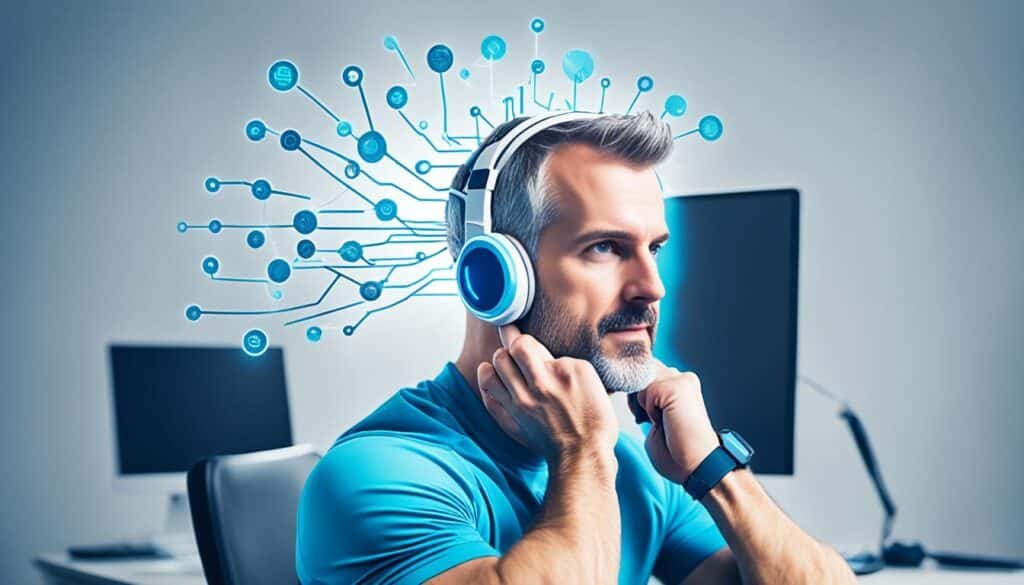
As a fan of neurohacking, I believe it’s key to add cognitive enhancement and biohacking to our daily routines. Our brains can change and adapt, much like a city grows and changes over time29. By living a neurohacking lifestyle, we can tap into our minds’ potential for better focus, creativity, and less stress29.
Techniques like mindfulness meditation, Cognitive Behavioral Therapy (CBT), and positive visualization can help us in our neurohacking journey29. It’s important to make these practices fit our own goals and likes29. Just as a garden needs regular care, sticking with neurohacking is crucial for its benefits29.
Using behavioral strategies can help us keep up with our neurohacking goals. This includes making goals fun, finding support, using games, and setting routines30. This way, we can keep changing for the better and enjoy the long-term perks of neurohacking.
“Neurohacking is like renovating a house, sculpting a masterpiece, or curating a personalized playlist. It’s a journey of self-discovery and optimization, where we uncover the best versions of ourselves through cognitive enhancement and brain optimization.”29
Studies show that simple things like walking in nature can calm our minds and work differently on the brain than walking in the city31. Tai Chi, an old Chinese practice, boosts brain function by creating new brain networks and making gray matter thicker31. These facts show how important it is to mix up our neurohacking activities.
| Neurohacking Practice | Benefits |
|---|---|
| Mindfulness Meditation | Reduces stress, improves focus and emotional regulation |
| Cognitive Behavioral Therapy (CBT) | Helps identify and change negative thought patterns |
| Visualization with Affirmations | Boosts motivation and self-confidence |
| Walking in Nature | Reduces rumination and activates specific brain regions |
| Tai Chi | Improves brain function by building neuro-network patterns |
When exploring neurohacking, we must be careful and aware of its risks and limits. By staying informed, connecting with others, and embracing new research, we can use neurohacking to improve our thinking and live better lives.
Expert Opinions and Perspectives
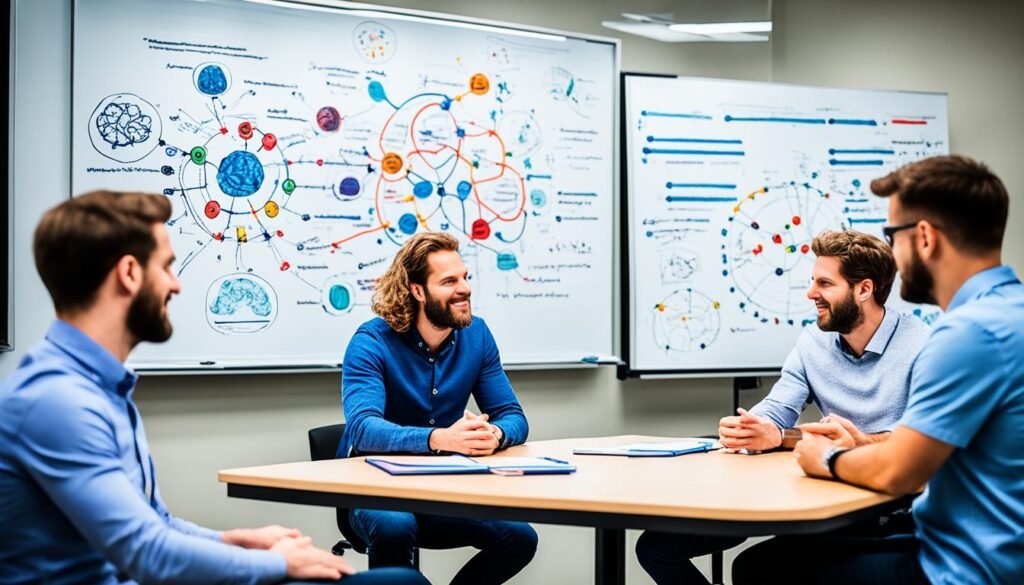
Neurohacking is getting more popular, and experts from different fields are sharing their thoughts. Elizabeth Ricker, a top neurohacking expert, has talked about how to improve our brains in the U.S. and other countries32. Her ideas have been on European TV and in the book “Science Not Silence” by the March for Science32.
Ricker wrote a book called “Smarter Tomorrow” that explains how to make our brains work better. She says starting to improve our mental skills is crucial today, especially in a world where thinking well is key in business and school32. The book offers simple and more advanced ways to boost our brains, like exercising, meditating, playing games, and using gadgets32.
Some neuroscientists think DIY brain tricks and other neurohacking methods could help us improve on our own. But, others warn against trying these things without expert advice. Neuroethicists worry about the safety and fairness of brain-boosting tech. They’re concerned about the risks of “white hat” and “black hat” hacking in biohacking and neurohacking33.
“Personalization through self-experimentation is key in neurohacking to determine what interventions work best for each individual.” – Elizabeth Ricker32
Entrepreneurs and futurists see a bright future where everyone uses brain-boosting tech. They believe it can make us more productive, creative, sleep better, feel less anxious, be more empathetic, and overall happier34.
The world of neurohacking covers many areas, like using special pills, exploring deep thoughts, studying gut health, using brain tech, and more34. It’s important to understand these different views to make sure we use neurohacking wisely.
As we move forward, thinking about our responsibility is key. It’s about being in charge of our actions, working together, sharing info, and trying new things34. Talking openly and listening to different opinions helps us use neurohacking safely and ethically.
Conclusion
Looking back on neurohacking, we see a new era of brain improvement ahead. DIY brain techniques like tDCS and nootropics are becoming popular for better mental performance35. But, we must use these tools responsibly and with care36.
Neurohacking raises big questions about fairness and the right use of brain tech36. We need to talk openly about these issues. This way, we can make sure neurohacking helps everyone, not just a few.
For a better future, we must focus on safety, consent, and privacy. This keeps cognitive enhancement safe and right. By doing this, we can make sure neurohacking is based on science and ethics.
The future of neurohacking is about connecting new research with real life. As more people try to improve their brains, we need to keep exploring neuroscience. By being informed and responsible, we can unlock the full potential of our brains. For those new or experienced in neurohacking, remember to keep an open mind and respect for neurotech ethics.
FAQ
What is neurohacking?
Neurohacking is about using techniques and tools to make your brain work better. It includes things like nootropics, brain devices, meditation, and brain exercises.
What are the most common forms of DIY brain stimulation?
DIY brain stimulation is often done with tDCS, tACS, and tRNS. These methods use low electricity on the head. You can make these devices yourself or buy them.
What are nootropics?
Nootropics are substances that boost brain functions. They help with things like memory, creativity, and motivation. Examples include Piracetam, Noopept, Ginkgo biloba, and Lion’s Mane mushroom.
What is brain training?
Brain training is about doing exercises to improve brain function. It includes memory games, puzzles, and exercises that help with attention.
How can meditation enhance cognitive function?
Meditation can improve focus, manage emotions, and reduce stress. There are two main types: focused attention and open monitoring meditation.
What are some popular neurohacking devices?
Popular devices include EEG headsets and neurofeedback tools. These let you record brain activity or get feedback on your brain states.
Is neurohacking safe?
Neurohacking can be risky if not done right. Using brain devices without a doctor’s help can cause burns or affect brain function. The long-term effects of nootropics and devices are still unknown.
What does the future of neurohacking look like?
The future of neurohacking looks exciting with new brain technologies. We’ll see more brain-computer interfaces and AI in neurotech. But, we need to think about ethics, safety, and rules for these advancements.
How can I integrate neurohacking into my daily life?
You can enhance your brain daily by taking nootropics, doing brain exercises, meditating, and using devices. Also, focus on good sleep, eating, and exercise. The goal is to find a mix of practices that help your brain work its best.
What do experts think about neurohacking?
Experts have mixed views on neurohacking. Some see it as a way to improve yourself, while others warn of risks. Neuroethicists worry about the safety and fairness of brain enhancement. Entrepreneurs and futurists see a future where everyone uses cognitive enhancement.
